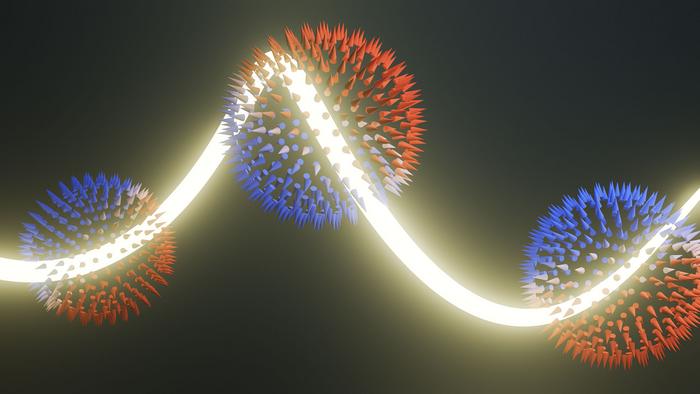Scientists have demonstrated the existence of orbital angular momentum monopoles in chiral topological semi-metals, marking a significant advance for the emerging field of orbitronics – a potential energy-efficient alternative to traditional electronics.
Summary: Researchers have observed orbital angular momentum monopoles in new materials, paving the way for more efficient information processing technologies that could reduce environmental impact.
Estimated reading time: 5 minutes
A groundbreaking study published in Nature Physics has revealed the presence of orbital angular momentum (OAM) monopoles in a new class of materials, offering a promising path forward for the development of energy-efficient information processing technologies. This discovery, made by an international research team led by scientists from the Paul Scherrer Institute (PSI) and Max Planck Institutes in Germany, could accelerate the advancement of orbitronics, an emerging field that aims to use the orbital properties of electrons for information transfer.
The Promise of Orbitronics
As the world grapples with the increasing energy demands of our digital age, researchers are exploring alternatives to traditional electronics that could reduce environmental impact. Orbitronics, which utilizes the orbital angular momentum of electrons, has emerged as a potential solution.
Michael Schüler, group leader at PSI’s Center for Scientific Computing, Theory and Data and co-leader of the study, explains the significance: “This offers a significant advantage to other materials because you don’t need to apply external stimuli to get OAM textures – they’re an intrinsic property of the material. This could make it easier to create stable and efficient currents of OAM without needing special conditions.”
The discovery of OAM monopoles in chiral topological semi-metals is particularly exciting because these structures allow for the uniform flow of OAM in all directions. This isotropy could enable the generation of information flows in any direction, a highly desirable property for practical applications.
Bridging Theory and Experiment
Despite the theoretical promise of OAM monopoles, their experimental observation has been challenging. The research team employed a technique called Circular Dichroism in Angle-Resolved Photoemission Spectroscopy (CD-ARPES) at the Swiss Light Source SLS to investigate two types of chiral topological semi-metals: those made of palladium and gallium or platinum and gallium.
The team’s rigorous approach to theory and experimental design was crucial in overcoming previous limitations in interpreting CD-ARPES data. By varying photon energies and meticulously analyzing the results, they were able to prove the presence of OAM monopoles and demonstrate how their polarity could be controlled.
Schüler notes, “At first, the data didn’t make sense. The signal seemed to be changing all over the place.” However, their persistence paid off, revealing that the CD-ARPES signal rotated around the monopoles as photon energy changed, rather than being directly proportional to the OAMs as previously believed.
Implications for Future Technology
This breakthrough has significant implications for the development of orbitronics devices. The ability to reverse the polarity of OAM monopoles by using crystals with mirror image chirality opens up possibilities for creating devices with different directionalities.
Moreover, the study provides the wider research community with the tools to explore OAM textures across various materials, potentially accelerating the optimization of materials for orbitronic applications.
Questions and Future Research
While this discovery represents a significant step forward, several questions remain:
- How do the energy efficiency gains of orbitronics compare to current electronic and spintronic technologies?
- What are the challenges in scaling up the production of chiral topological semi-metals for practical applications?
- How might OAM-based devices integrate with existing information processing technologies?
As research in this field progresses, these questions will likely be addressed, paving the way for the next generation of energy-efficient information processing technologies.
Quiz
- What property of electrons does orbitronics aim to use for information transfer?
- What type of materials were used in this study to observe OAM monopoles?
- What technique was used to experimentally observe the OAM monopoles?
Answers:
- Orbital angular momentum (OAM)
- Chiral topological semi-metals
- Circular Dichroism in Angle-Resolved Photoemission Spectroscopy (CD-ARPES)
Further Reading
Glossary of Terms
- Orbitronics: An emerging field that uses the orbital angular momentum of electrons for information processing.
- Orbital Angular Momentum (OAM): A property of electrons related to their motion around an atomic nucleus.
- Chiral Topological Semi-metals: A class of materials with a helical atomic structure that naturally possess OAM textures.
- OAM Monopoles: Points where OAM radiates outwards uniformly in all directions.
- CD-ARPES: A spectroscopic technique using circularly polarized X-rays to study electronic structures of materials.
- Isotropy: Uniformity in all directions.
Enjoy this story? Get our newsletter! https://scienceblog.substack.com


